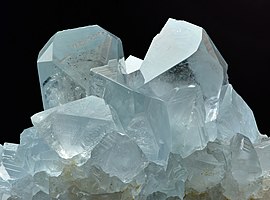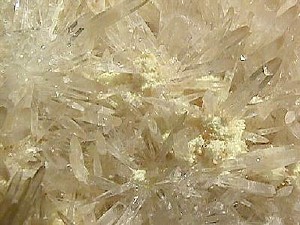天青石
| 天青石 | |
|---|---|
 洁净的灰蓝色天青石晶体 | |
| 基本資料 | |
| 類別 | 硫酸盐矿物 |
| 化学式 | SrSO4 |
| IMA記號 | Clt[1] |
| 施特龙茨分类 | 7.AD.35 |
| 晶体分类 | 双锥体 (mmm) H-M记号:(2/m 2/m 2/m) |
| 晶体空间群 | Pnma |
| 晶胞 | a = 8.359 Å, b = 5.352 Å, c = 6.866 Å; Z = 4 |
| 性質 | |
| 顏色 | 白色、粉红色、淡绿色、淡棕色、黑色、淡蓝色、红色、灰色;透射光下无色或浅色 |
| 晶体惯态 | 板状到锥体状晶体,也有纤维状、层状、土状、块状颗粒 |
| 晶系 | 正交晶系 |
| 解理 | {001}完美,{210}良,{010}差 |
| 断口 | 参差状 |
| 韌性/脆性 | 脆 |
| 莫氏硬度 | 3 - 3.5 |
| 光澤 | 玻璃光泽,解理珍珠光泽 |
| 條痕 | 白色 |
| 透明性 | 透明到半透明 |
| 比重 | 3.95 - 3.97 |
| 光學性質 | 双轴 (+) |
| 折射率 | nα = 1.619 - 1.622 nβ = 1.622 - 1.624 nγ = 1.630 - 1.632 |
| 双折射 | δ = 0.011 |
| 多色性 | 弱 |
| 2V夹角 | 測量: 50° - 51° |
| 色散率 | 中等 r < v |
| 發光性 | 短紫外线=黄、白蓝、长紫外线=黄、白蓝 |
| 參考文獻 | [2][3][4][5] |
天青石(英語:Celestine[6]或Celestite[7])是一种由硫酸锶组成的矿物。这种矿物因其偶尔出现的精致蓝色而得名。天青石和菱锶矿是锶元素的主要来源。
發現[编辑]
天青石以晶体形式出现,也以紧凑的块状和纤维状形式出现。它主要存在于沉积岩中,通常与矿物石膏、硬石膏和岩盐有关。 这种矿物遍布世界各地,通常数量很少。在马达加斯加发现了淡蓝色的晶体标本。白色和橙色的变种也出现在英国布里斯托尔的Yate,直到20世纪中叶,它才被提取用于商业目的。[8] 与其他放射虫的骨骼由硅石组成不同,等辐骨亚纲原生动物的骨骼是由天青石组成的。
在碳酸盐海相沉积物中,埋藏溶解是公认的天青石沉淀机制。[9]它有时被用作宝石。[10]
-
来自波兰,Machow矿的天青石
晶洞[编辑]
在一些晶洞中发现了天青石晶体。世界上已知最大的晶洞,最宽处直径为35英尺(11米)的天青石晶洞,位于俄亥俄州普特因湾的伊利湖南巴斯岛附近。晶洞已被改造成观景洞,曾经构成晶洞底部的晶体被移除。晶洞有宽达18英寸(46厘米)天青石晶体,估计每个重达300英磅(140公斤)。
天青石晶洞被认为通过替换由硫酸钙组成的石膏或硬石膏组成的雪花石膏结节而形成。硫酸钙微溶,但硫酸锶大多不溶。与硫酸钙结节接触的含锶溶液将钙溶解掉,留下空洞。锶立即沉淀为天青石,晶体生长到新形成的空腔中。[11][12][13]
-
天青石晶洞剖面
-
俄亥俄州的水晶洞内
参考资料[编辑]
- ^ Warr, L.N. IMA–CNMNC approved mineral symbols. Mineralogical Magazine. 2021, 85 (3): 291–320 [2022-02-10]. Bibcode:2021MinM...85..291W. S2CID 235729616. doi:10.1180/mgm.2021.43. (原始内容存档于2021-11-19).
- ^ Mineralienatlas. [2022-04-09]. (原始内容存档于2022-01-27).
- ^ Handbook of Mineralogy (PDF). [2022-04-09]. (原始内容 (PDF)存档于2008-09-06).
- ^ Mindat.org. [2007-12-19]. (原始内容存档于2007-12-11).
- ^ Webmineral data. [2022-04-09]. (原始内容存档于2014-01-11).
- ^ List of Minerals. 21 March 2011 [2022-04-09]. (原始内容存档于2021-12-20).
- ^ Nickel, Ernie.; Nichols, Monte. Mineral Names, Redefinitions & Discreditations Passed by the CNMMN of the IMA 互联网档案馆的存檔,存档日期May 30, 2008,., Materials Data, 2004, p. 26. Celestine is the approved name for this mineral by the International Mineralogical Association Commission on New Minerals and Mineral Names (CNMMN). Although celestite finds frequent usage in some mineralogical texts, the name has been discredited as a valid mineral name by this organization.
- ^ Beneath our Feet | History of Yate | Home | Discover Yate's History at Yate Heritage Centre. [2022-04-09]. (原始内容存档于2019-12-30).
- ^ Baker, Paul A.; Bloomer, Sherman H. The origin of celestite in deep-sea carbonate sediments. Geochimica et Cosmochimica Acta. 1988, 52 (2): 335–339. Bibcode:1988GeCoA..52..335B. doi:10.1016/0016-7037(88)90088-9.
- ^ Tables of Gemstone Identification By Roger Dedeyne, Ivo Quintens p.174
- ^ Anenburg, Michael; Bialik, Or; Vapnik, Yevgeny; Chapman, Hazel; Antler, Gilad; Katzir, Yaron; Bickle, Mike. The origin of celestine–quartz–calcite geodes associated with a basaltic dyke, Makhtesh Ramon, Israel. Geological Magazine. 2014, 151 (5): 798–815. Bibcode:2014GeoM..151..798A. S2CID 129529427. doi:10.1017/S0016756813000800.
- ^ Carlson, Ernest. Celestite replacements of evaporites in the Salina Group. Sedimentary Geology. 1987, 54 (1–2): 93–112. Bibcode:1987SedG...54...93C. doi:10.1016/0037-0738(87)90005-4.
- ^ Kile, Daniel; Dayvault, Richard; Hood, William; Hatch, H. Steven. Celestine-Bearing Geodes from Wayne and Emery Counties, Southeastern Utah: Genesis and Mineralogy. Rocks & Minerals. 2015, 90 (4): 314–337. S2CID 130452012. doi:10.1080/00357529.2015.1034489.
| 维基共享资源上的相关多媒体资源:天青石 |
外部連結[编辑]
 Celestine. Encyclopædia Britannica 5 (第11版). London. 1911.
Celestine. Encyclopædia Britannica 5 (第11版). London. 1911.
| ||||||||||||




